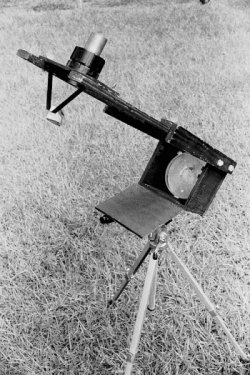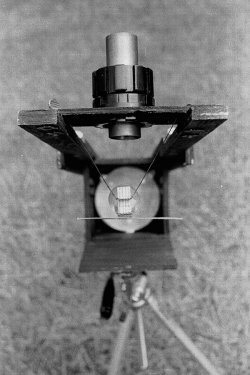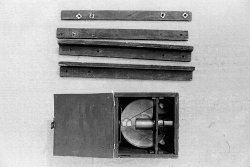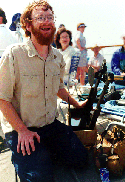
Last touched 2024 July 12

Discovering astronomy as a high school senior in 1980, I was soon lusting after a 6-inch f/8 Criterion "Dynascope" equatorial mounted Newtonian as much, if not more, then I lusted after the cheerleaders at school. That should have been a hint of the future to come.
Alas, I didn't have much money to spare and neither did my family. So I did what every poor astro-geek did then: I ordered a 6-inch mirror grinding kit from Jaegers. It wasn't long before my mother was complaining that the #60 grit was rubbing off the design of the kitchen counter top. Sorry mom.
I had just completed rough grinding when I graduated from school and enlisted in the US Navy as a photographer. Nine months later, I was at sea on the aircraft carrier USS America, based out of Norfolk, Virginia. I had already been observing from the ship with binoculars and a little 4 1/4-inch f/4 RFT Coulter Optical kit that I would later build into a scope called "Pringles."
At some point, I had visited the house in Columbus, Ohio and had hauled back to the ship the 6-inch mirror kit. The carrier was leaving on an eight-month cruise to the Indian Ocean, perhaps I'd find the time and place to work on the mirror.
Four months into the cruise, I was put to work in a tiny film-processing darkroom. There was just enough room on a counter in the room to finish the rough and fine grinding. Just after getting back from the cruise, I was reassigned to work in a much larger color print processing room. In this room, there was more counter space and enough floor space to test the mirror. I learned the temperature of the photo lab's coffee pot heater was just hot enough that I could melt the pitch in a steel 100ft 35mm film can.
I tested the mirror by taping a razor blade to a block of wood. I put a light bulb in a box and poked a pinhole in it. I taped a piece of paper on the darkroom floor and put the block of wood on it. As I looked at the shadows crossing the surface of the mirror, I would draw a line on the paper against the block. I used a loupe and ruler to measure the distance between the lines and roughed out the math out of ATM book 1 (my only mirror making resource) for figuring the mirror. It didn't take long to get numbers that looked pretty good. I would only be using the scope for low power work anyway, since the ship rocked on the open seas.
While the mirror was out being coated, I built a really, really crude "board" tube assembly. Good enough to test. The mirror came back from Clausing while we were at sea on a training cruise off the Virginia Capes. Damn if the thing didn't focus. I could not believe my eyes. I had built a telescope. But the mirror had arrived back from the coater with a note: "Not polished out." Yep, there was a gray haze around the outer inch of the mirror.
Fired up, I went back to polishing and soon had it clear as a bell. Back to figuring the surface again. This time, I wasn't so lucky. Try as I might, it was over corrected or under corrected. After a month of fooling with it, I finely gave up and sent it back to the coaters, knowing that it was under corrected. Actually, under corrected by a lot, although I didn't know how much.
While the mirror was gone and the ship was in port, I visited the base wood shop and spent a day cutting pieces for a simple tube assembly. While home on leave, I had seen photos of a ultra compact telescope by St Louis amateur Thane Bopp (Here's a 2nd generation version of his scope). Tom Burns and Dick Suiter had also given me some ideas.
The scope had to be really compact because I only had so much locker space on the ship. The deepest locker I had access to was only 7-inches deep. I had to be able to carry the scope up 11 stories to my normal observing station between the ship's bridge in a single trip. The stairs going up these stairs were steep, almost ladders. I needed to be able to carry everything; the scope, a small tripod, my charts and eyepieces in a single bag. For this, I acquired a "flight bag" from one of the ship's parachute riggers (See here for a description of observing from the ship).
The final design is actually quite simple. A box holds the mirror. It's just deep enough and just the right width that a board that holds the focuser will store inside the box for storage. The focus board is connected to the mirror box with two L shaped wood struts. Each strut is two pieces, each about 16-inches long. Everything is held together by thumbscrews that screw into tee-nuts. The box is designed just so the focus board will fit inside the box for travel. A hinged lid protects the optics when not in use.
The focuser was fun to make. From a ship's electrician, I obtained a bulkhead (wall) fitting for a 1-inch cable. This fitting was supposed to be used to keep the bulkhead watertight as the cable goes through it.. I used a round file to enlarge the opening large enough so apiece of brass 1.25-inch tubing (from Jaegers) to fit.
The mirror box attached to a small photo tripod. The set up worked great. The mirror was clearly undercorrected, but worked fine at the less than 50x powers I used.
Over the next three years, the scope made two trips to the Indian Ocean (four transits through the Suez canal), one trip to the North Sea and several training cruises to the Caribbean Sea. Other than galaxy observing, I did a lot of variable star observing for the AASVO with the scope. During the Indian Ocean trips, it made one visit below the equator and saw the LMC and SMC and many of the famous southern objects. I drew Eta Carina, resolved Omega Centuri, and other cool things. In 1984, I wrote up a description of the telescope, took some pictures and Richard Berry published them in Telescope Making Magazine issue 22 (Spring, 1984).
After leaving the Navy in 1985, I built a square tube Dobsonian mounting for the 6-ich optics in my parent's garage in Columbus, Ohio. The Navy/Boppian hardware went into storage. I used this scope during 1985/6 to observe Milky Way clusters and more specifically Comet Halley. At a public star party in south Columbus in early 1986, a couple of hundred people glimpsed a so-so comet Halley through the scope.
Since I had access to larger scopes, including a very fine 10-inch f/5.6 boppian, the square tubed 6-inch scope spent a lot of time in my apartment, covered with an Australian flag I had acquired while in Perth, Australia in 1981. On occasion, it would be pulled out, cleaned up and taken on an observing run. I wrote about this period of the telescope's existence in the April, 1991 issue of M-111, the newsletter of the Richland Astronomical Society.
In 1991, the scope moved with me to Bowie, Maryland.
In 1995 and 1997, it served to provide views of Comets Hyakutake and Hale-Bopp. In April of 1997, it traveled to Sky Line Drive in Shenandoah National Park for one of these trips. On another trip, it went to the Eastern Shore of Maryland.
In 1997, my wife Cathy and I decided to take a cruise to see the great solar eclipse from near Aruba. I decided it would be fun to take the 6-inch to sea again, with the hope of observing a couple of southern globular clusters that I haven't seen before (I've seen almost all of the northern globulars that can been seen) from the deck of the cruise ship.
Pulling the optics out of the square tube scope, I remounted them in the Navy/Boppian OTA. I briefly considered repainting the now very beat up and scared OTA, but decided against it: all those scratches and whatnot were all badges of honor! But there was another problem: the tripod I had used on the USS America had broke several years earlier. A search for a new tripod what would be small enough, yet sturdy enough didn't find a good solution, or at least a solution that I though was worth the money.
A hunt through my scrap woodpile soon answered my problem. I could build a Dobsonian "add-on" bearings and cradle without adding much weight or bulk to the scope. A couple of evenings in the shop solved this problem and actually makes the scope more of a pleasure to use then the original tripod mount. I had considered building a wood tripod similar to the tripod Ron Ravneberg built for his Alice, but never got around to it. Instead, I just observed from the deck of the ship.
The eclipse trip was a huge success. While I picked off a couple of globulars from the darkened after deck of the MV Fascination, the scope came into best use for projecting the progress of the eclipse on a large piece of cardboard. Most people surrounding us on the desk appreciated this status report and many people videotaped and photographed it.
In July 2000, Cathy and I visited the Table Mountain Star Party while visiting her parents in Washington State. It was a natural to take the 6-inch RFT, especially since I had recently started observing Arp Galaxies. While most Arp galaxies are faint and require larger telescopes, several are bright and clearly within reach of the 6-inch. Because we would be traveling with a 1-year old, the trusty 6-inch was entirely packed in a checked bag (normally, I like to carry the mirror/optics box onboard). I even packed my old flight bag to provide something to carry the scope to and from the camper we would be using at the party.
When Cathy and I weren't exploring the gems of the Milky Way with the scope from atop Table Mountain, I made drawings of seven Arp galaxies, including M-32, M-82, NGC 1023, NGC 7727 and NGC 5566.
For these trips, I normally take a very small and lightweight observing kit. The kit includes a copy of the Bright Star Atlas, 32, 24 and 16mm Brandon eyepieces. For specific objects I know I want to observe, I use the Megastar star-charting program to create custom charts before I leave home.
While I've recently completed a 12-inch Suitcase Telescope named Ellie that will take the 6-inch f/5's place on many trips (like the 2001 TMSP), the 6-inch remains safe, sound and awaiting the call of duty.
Skip to ... 2006!
We normally make regular trips from Bowie, Maryland to Pasco, Washington, to visit Cathy's parents. For the trip in 2006, there was a planned camping trip to Yellowstone National Park. Taking the large 12-inch "Ellie" telescope might have been workable, but clumsy at best, especially given the long set up time required for Ellie and the unknown observing locations I would be dealing with.
So with little fanfare, the 6-inch came out of retirement. A cleaning of the mirror(s) and some minor tweaks and she was ready to go. For this trip, she travelled in Maggie's suitecase, checked for the three-legged flight from BWI to Pasco. Once in Washington, she was assembled and made the trip to Yellowstone on the backseat of a pickup truck.
Observing sessions were made from a RV park in Hagerman, ID, and from the KOA in West Yellowstone, MT. All sessions reenforced the reason for bringing her instead of Ellie. Local light pollution from nearby campers and street lights in the KOA allowed me to pickup the observing kit and OTA and hike to a location free from glare and be set up and observing in a minute. In one case, this was just a picnic table in an unused campsite.
Now skip forward to June of 2012. A trip was planned to visit Grandma's in Pasco in time for the last transit of Venus until the year 2117. Pasco was picked because the area experiences 300 clear days per year, and the west coast offered a longer viewing period... we would have more time to get to clear skies. Knowing we would have a rental car and because of the nature of the event, aperture wasn't all that important. So the trusty 6-inch was pulled out of storage and dusted off, still in the compact form. Except for now it needed to be converted into a solar telescope! To do this, I aquired some Baader solar film to use as the filter. I mounted this between some foam buildilng insulation and card board. This was rigged to slide over the top of the two struts. I then made cardboard shrouds to block stray light. These are duck taped in place since usage in this form will be rare. Once in Pasco, the telescope was assembled and was small enough to fit in the trunk of the rental car for easy and quick deployment once on site.
Indeed, the weather at the home site was cloudy, so a road trip was made south, into Oregon. It turned out to be a nice drive through some wonderful country. Several stops where made once clear skies were found and a number of observations of the transits were made.
In August of 2017, complex plans to see the total eclipse from Oregon fell through. A last minute trip was made to a friends house in Kansas City. His house was under the path. The weather was spotty and we were ready to drive, but a friend at the weather service who had early access to the 1km resolution satellite imagery from the GOES-R satellite recommended we stay put. We did and were rewarded with a very nice view through thin high clouds. Through out the event, the trusty 6-inch, that once again had made an airline trip, projected the image for friends and neighbors to watch.
In early April, 2024, I once again found myself digging the 6-inch out of storage, cleaning the mirror, making a couple of minor repairs and adjustments (mostly to the secondary mirror support), mated to the old flight bag, to get it ready for it's third total eclipse of the Sun. This time, it rode in the car to Sandusky, Ohio. Having learned from 2017, our plans were simple. Drive to a hotel on near the center line, get up that morning to check weather, drive if needed, stay put if not. We set up in the hotel parking lot and soon attracted hotel staff, others staying the htotel and staff from a nearby restaurant (who kept bringing out drinks). The 6-inch did it's job and projected the event on a large piece of cardboard so that all could see at same time.
During totality, we shared direct views of the Sun/Moon through the eyepiece. In the final seconds, a stand out view of bright red solar prominences presented itself and burned a lifetime image into my brain. What a great event and what a reflection from a piece of optic made so long ago and so far away! In 1984, I used the basic concepts of this telescope to construct a very fine 10-inch 10-inch Boppian Telescope now owned by Brent Archinal of Flagstaff, Az. I also used this design to rebuild my 4.25-inch RFT, Pringles into a very similar telescope.
I find it somewhat amusing that these days (2003), telescopes very similar to my vintage 6-inch are all the rage. I've seen similar telescopes at star parties that use the basic concepts and ideas used in this scope. I've received more than my share of credit from Ron Ravneberg (thanks Ron!) in his many articles about his wonderful travel scopes. Because of this telescope, I've also always had a very special relationship with Thane Bopp, a real true-blue honest to god telescope maker if there ever was one. Thane's scopes have more original ideas in than just about anyone else I know.










/center>




Back to Bob's Homepage.